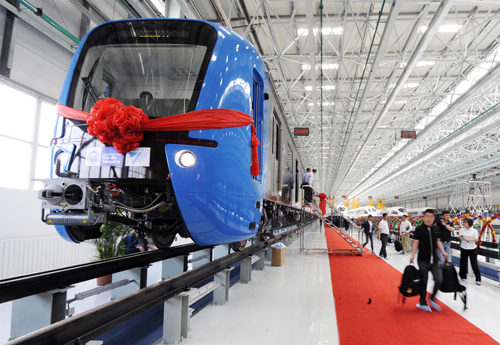|
 |
|
MADE FOR SOUTH AMERICA: The first electric multiple unit train developed by China for Brazil comes off the assembly line in Changchun, northeast China's Jilin Province, on June 7 (WANG HAOFEI) |

The free trade agreement (FTA) between China and Costa Rica, signed in April 2010, came into effect on August 1. It was the first free trade pact between China and a Central American country, and the third between China and a Latin American country following Chile and Peru. The agreement will not only promote trade and investment between the two countries, but also push forward China's relations with Central America and the whole Latin American region.
A closer economic and trade relationship between two of the most powerful engines driving the world economy—China and Latin America—will definitely help alleviate the current wave of financial woes around the globe.
More than 90 percent of goods from China will gradually enjoy zero-tariff access to Costa Rica within the next 15 years, and at least 60 percent of the goods started to enjoy the zero tariff access on August 1. Likewise, at least 95 percent of goods from Costa Rica will gradually enjoy zero-tariff access to China within the next 15 years, and more than 65 percent of the goods started to enjoy the zero-tariff access on August 1.
Trade boom
Before China and Costa Rica established diplomatic relations in 2007, their bilateral trade already ranked first between China and Central American countries. China exported machinery, electrical products and light industrial products to Costa Rica, and imported agricultural products from Costa Rica.
Since 1998 when Intel Corp. set up a factory in Costa Rica, electronic products became Costa Rica's major export products and gradually surpassed agricultural products as major export products to China. The huge demand of China's electronic information industry made China Costa Rica's second largest export market. A solid trade foundation encouraged Costa Rica to establish diplomatic relations with China in 2007. It was the first Central American country to establish diplomatic relations with China.
Closer political ties further consolidated the economic and trade relations. Both sides realized the necessity of establishing a mechanism to ensure the sound growth of their economic and trade relations. In January 2009, the two countries launched negotiations on the Sino-Costa Rican FTA, which was signed in April the following year.
There are a number of reasons why China explored an FTA with Costa Rica. The two countries' trade structure is not as complicated as trade structures between China and its other major Latin American trade partners. Trade frictions between China and Costa Rica are infrequent. China's strength lies in mechanical and electrical industries and the light industry, while Costa Rica is competitive in electronics, agriculture and animal husbandry. A trade expansion between them will not severely impact their domestic industries.
The smooth development of their political and economic relations also paved the way for an FTA. Since the establishment of diplomatic relations, the two sides have conducted frequent high-level exchanges. Former Costa Rican President Oscar Arias Sanchez visited China in 2007 and Chinese President Hu Jintao visited Costa Rica in the following year. The two countries provided assistance to each other in difficult times such as China's massive Wenchuan earthquake in May 2008 and Costa Rica's landslide in November 2010.
| 